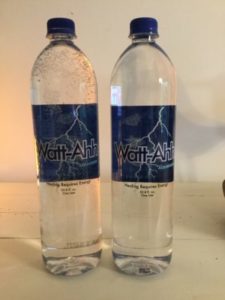Update on October 29, 2018
In response to about ten customers that reported a burn oil smell from liter bottles produced on October 12, 2018, we have since coordinated with the bottling plant manager on making improvements. The pump that uses food-safe vegetable oil to draw water out of the tank for bottling has been replaced with a new pump along with new hoses.
On October 29, 2018, we received results from Xenco Laboratories. Four samples produced on September 15, 2018 (14:19 hours), October 12 2018 (07:33 hours), October 12, 2018 (09:24 hours) and October 12, 2018 (13:33 hours) were analyzed for volatile organic compounds using Method 8260B. No volatile peaks were detected for the water produced on October 12, 2018 (3 of the four samples).
For the fourth sample produced during an earlier run (September 5, 2018), both bromodichloromethane and chloroform showed peaks which are identified as chemicals in the group of trihalomethanes. These chemicals are formed as by-products from chlorine disinfection used in the municipal water supply (incoming water to the bottling plant). The results fall below the U.S. EPA drinking water standards. We understand from the plant manager that the reverse osmosis resin, used to remove chlorine, was renewed sometime after that production and before the most recent production (October 12, 2018). No volatile organic peaks were detected by Xenco Labs for the water produced on October 12, 2018.
If anyone is interested in receiving a pdf version of the Xenco lab results, please email Dana Gourley at dana@aquanew.com.
Our Previous Post
Watt-Ahh is ozone-free ultra-pure water. AquaNew uses a multi-level purification process intended to remove all contaminates in the base water (less than 1 ppm total dissolved solids) before the Dioxytetrahydride Gas (H4O2) is infused into the water. We diligently work to remove contaminates and it makes no sense to add ozone to the water gas-treated water before bottling. For more information on our purification and polarization process, please visit this link.
We are no fans of ozone. It releases a nascent oxygen that is highly oxidative. Ozone, for instance, is used to clean c-pap equipment. Typically, there is no human exposure while a closed system applies ozone to the equipment and some time must elapse before the system is opened to retrieve the equipment. Over time, ozone will start corroding the c-pap equipment.
Ozone is traditionally used in water treatment and the same used in the bottled water industry as a final treatment for either filtered municipal water or spring water prior to bottling.
We specify, however, to the bottling plant that no ozone is added. The reason? The special crystalline-like structure of Watt-Ahh stabilizes compounds such as hydrogen peroxide (H2O2) and chloride oxides used in wound care products. The nascent oxygen associated with the breakdown of ozone has a longer residence time absorbed in the Polarized Water and will either oxidize or “burn” the plastic bottle, causing a smoky plastic odor when someone first removes the cap of the bottle.
Problem: We recently discovered when we received complaints from several customers that they detected a different smell when they opened a Watt-Ahh liter bottle. We immediately met with the bottling plant manager and sampled each pallet produced this month (October 2018). It has been concluded that the ozonator was turned on when the employees came back from lunch to complete the Watt-Ahh production. AquaNew will no longer sell those bottles produced after the lunch break.
Is the water safe to drink? Yes. We find that pouring the water into another container and let it be exposed to the air or uncapped and placed in the refrigerator for some minutes, seems to make the water appealing to drink.
The bottling plant is required by government to test water being used for bottling. We will be immediately arranging testing of the water produced this month by an independent lab and upon receipt of those results, we will update this article and provide the results.
However, our policy is to strive for 100% satisfaction and deliver the highest quality Watt-Ahh to our customers. We accept the word of the plant manager that adding ozone to Watt-Ahh will not happen again and we are also coordinating with him on additional protocols to safeguard against infusion of ozone into the Polarized Water.
Replacement offer: If a customer detects a problem and notifies use within 14 days of receipt of the product, we will offer either a replacement case or a refund. Please call Dana direct at 941-923-8972. If you are not drinking the water, please pour on your favorite plants or in the vase of cut flowers … they will flourish.
AHA! Scientific Silver Lining: Through this experience, it got our scientific noodles going. Health practitioners are using ozone-related therapies for a number of diseases. Contingent upon any required FDA approval, we will license a credible company on the use of the Polarized Water as part of their ozone therapy.

Photo taken on October 26, 2018. The bottle on the left was produced in October 2018 and has bubbles extending from the bottom to the top of the bottle. The bottle on the right was produced in September of 2018. A few bubbles near the top of the water column is normal but the bottle on the left with a higher amount of bubbles is evidence of ozone stability.
